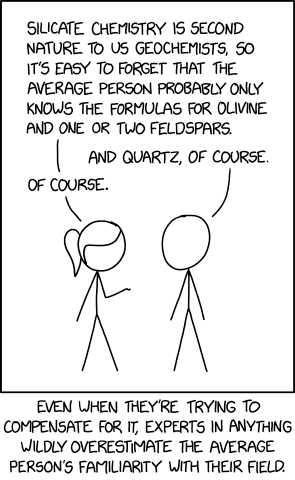Epistemic status: casual observation written as first draft but published as-is because it was unlikely to ever actually get edited.
There's a common failure mode I see among EAs and particularly rationalists where they fail to translate their thoughts back into something comprehensible when communicating. This post is just explaining what I mean by this.
Visual Summary

Verbal thought
Many people think verbally. Some people think pictorially or in some other fashion, but most people, most of the time, construct their thoughts as something-like an ongoing sentence made up of words.
For most people, this is a really useful feature! When you want to share things with somebody, the level of 'translation' from your thoughts to language is very low. Everybody I know who struggles with verbal speech thinks in a non-verbal format (which could of course cut both ways causally).
Less-verbal thought
There are three key problems introduced by rationalism to the usual process above; jargon, the rationalist desire for intense precision, and thinking truly weird thoughts in general.
This is less specific to rationalism/EA, but many people think in words which other people don't know. Even when they try to translate their jargon into something more understandable, they underestimate the inferential distance, or they map words poorly (where an equivalent doesn't exist in 'normal English') such that most of the meaning is lost.
When this is combined with the rationalist desire for extreme precision in speech and thought, it contributes to unpleasant listening and bad communication. If people can get a 1-sentence summary which means 90% the same thing as what you're thinking, this is (usually!) better than people getting an hour-long lecture on your specific subdomain of AI alignment just to understand a peripheral point. It's ok if people don't know your precise epistemics for a passing comment. No really, I promise.
This is worsened further by the fact that a key recommendation for rationalists is 'thinking weird thoughts'. Rationality often involves inspecting the terms you're using, defining them as narrowly as possible, and trying to actually use them in this way. This is good for thought, but bad for communication. If you're planning to use a word a lot, or if your definition varies a lot from the standard one, it's worth defining it-- but track this actively! Some of the time it's ok to be misunderstood a little to avoid being unlistened to a lot.

Remember to interpret
So, if you're a rationalist who thinks very strange thoughts and/or has invented a whole buch of concepts for which only you have verbal handles, remember to translate your thoughts back into English before saying them aloud. Similarly, if you seem to be miscommunicating about something important, try interpreting again into something closer to your true thoughts.
Here's a worked example (which is by its nature hard to give, because the 'less-verbal' thought necessarily has to be verbalised to be written down):
Precise, but lengthy: Benzodiazepines are [unlikely to cause physiological withdrawal symptoms if stopped appropriately, compared to other drugs] but probably [cause people to narrow the level of anxiety they find tolerable] and [cause them to become less accustomed to using other coping mechanisms, such that people are practically worse off for a period after stopping benzodiazepines], and this is [likely a major contributor to the creation of guidelines which encourage doctors to limit the length of a course of benzodiazepines].
Less precise, but easier to read: Benzodiazepines are not very physiologically addictive (withdrawal symptoms are rare), but may be psychologically addictive (people get used to how they feel), and this is why doctors don't like to prescribe benzodiazepines.
Imprecise and very brief: Benzodiazepines are not very physiologically addictive, but may be psychologically addictive, so doctors try to limit their use.
Note I'm not claiming any of these is superior to the others! Each of these has its place, depending on audience and importance. The first one is closest to my thoughts, and is represented in a much more concise way inside of my brain such that it's hard to notice how compressed it is until I attempt to verbalise it. The square brackets in the first example are each roughly a single thing I can point at in my head easily, but which I doubt are that for most readers.
Conclusion
All speech sits along an axis of thought-like-ness (thoughtiness?). Most of the time, thought-like-ness is a secondary concern to speed and immediate clarity, but not always.
Actively tracking thought-like-ness, or having it come to mind when you find yourself confused about a disagreement or find yourself being misunderstood, may be a useful skill to improve your ability to communicate well with a wide variety of audiences.
